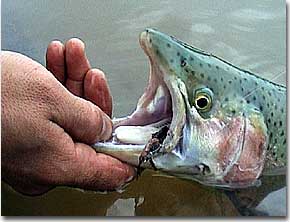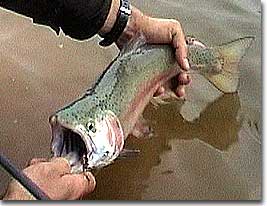Fly-Fishing for Trout: Instinct Vs Technique
Fly-Fishing for Trout: Instinct Vs Technique
 Mention excitement, acute alertness and strenuous exercise and few would consider you were speaking about fly-fishing. These descriptions are reserved, in most minds for spectacular sports like mountaineering or hang gliding. To some, though, they accurately describe fly-fishing for trout; they portray the fine art of stalking (hunting) trout. To become a successful stalker of trout, one must have a thorough understanding of a trout's main alert mechanisms to danger; that being their eyesight and sound senses.
Mention excitement, acute alertness and strenuous exercise and few would consider you were speaking about fly-fishing. These descriptions are reserved, in most minds for spectacular sports like mountaineering or hang gliding. To some, though, they accurately describe fly-fishing for trout; they portray the fine art of stalking (hunting) trout. To become a successful stalker of trout, one must have a thorough understanding of a trout's main alert mechanisms to danger; that being their eyesight and sound senses.
Trout have acute eyesight. Their eyes are placed laterally on their head and are tilted forward and upward. Vision is therefore restricted downward and to the rear. A blind spot is thus created behind a fish, about 35 degrees on either side. High objects to the rear are still in sight. Always keep this fact in mind when stalking trout, as it enables the angler to approach (if in the right position) undetected by the fish. This is also the main reason why I always recommend fishing a stream or river upstream instead of downstream; as you are less likely to spook any fish that are present before they are spotted by your own eyes. Trout are extremely sensitive to movement. Stationary objects often remain unobserved, while movement probably suggests one of two things, danger or food. In our case (the fisherman) is seen as danger to the ever cautious trout. Therefore whenever possible, approach a waterway low and slow, and use any natural camouflage to your full advantage to hide the silhouette of your image. It is also extremely important to wear natural colored clothing, as trout do have the ability to distinguish colors. Wearing bright colored clothing e.g. reds, yellows etc will severely handicap your results, particularly in areas of high water clarity. Shadows are another key factor to keep in your mind while stalking trout. Your own personal shadow, if allowed to cast over the waterway you intend to fish, will quickly spook any fish present.
The trout sees it as danger due to its terrestrial movement. In areas of extreme water clarity even the shadow generated from your rod or flyline can be enough to spook trout. Therefore always consider the sun, as an angle of shadow will be cast from yourself, or gear, potentially spooking the fish you have just spotted.
 Trout have a well developed sense of hearing, not surprising given that sound moves fives times faster through water than through air. Trout have two detection systems for sound: One being ears on either side of a trout's head, and are buried, in similar position to the inner ears of human beings. These ears are primarily used for far field sounds. The other sound detection device is the lateral line. It can be seen on a trout as a distinct line from head to tail on both sides of the fish. The lateral line detects near field sounds. As you can appreciate these two systems combined give a trout great sound detection ability. One myth I must dispel is that normal talking is not perceptible to fish. This is due to 99.9% of sound energy in the air is reflected from the waters surface. Therefore the main point to remember when stalking trout in reference to sound is the ground you are walking on, as it is technically just an extension of the river bed or lake bottom. Sound can quickly travel back to the fish alerting it of danger, especially if you are treading heavy footed, knocking rocks together, grinding gravel, braking twigs or branches etc. while traversing the river bank or wading. A stalking fisherman must continually remind himself of the importance to tread softly when walking along a bank or not to knock rocks together when wading; I cannot emphasize this point enough! In conclusion trout have highly developed sensory mechanisms as they depend on them for their survival. In realizing this fact we can use it to our advantage while stalking trout. Always remember to do the following actions and success will come more readily:
Trout have a well developed sense of hearing, not surprising given that sound moves fives times faster through water than through air. Trout have two detection systems for sound: One being ears on either side of a trout's head, and are buried, in similar position to the inner ears of human beings. These ears are primarily used for far field sounds. The other sound detection device is the lateral line. It can be seen on a trout as a distinct line from head to tail on both sides of the fish. The lateral line detects near field sounds. As you can appreciate these two systems combined give a trout great sound detection ability. One myth I must dispel is that normal talking is not perceptible to fish. This is due to 99.9% of sound energy in the air is reflected from the waters surface. Therefore the main point to remember when stalking trout in reference to sound is the ground you are walking on, as it is technically just an extension of the river bed or lake bottom. Sound can quickly travel back to the fish alerting it of danger, especially if you are treading heavy footed, knocking rocks together, grinding gravel, braking twigs or branches etc. while traversing the river bank or wading. A stalking fisherman must continually remind himself of the importance to tread softly when walking along a bank or not to knock rocks together when wading; I cannot emphasize this point enough! In conclusion trout have highly developed sensory mechanisms as they depend on them for their survival. In realizing this fact we can use it to our advantage while stalking trout. Always remember to do the following actions and success will come more readily:
· Use the 35 degrees blind spot rule to your advantage at all times
· Move low and slow when approaching a waterway, using natural camouflage to disguise your silhouette at all times.
· Wear natural colored clothing, no fluorescent or bright colors.
· Always be aware of the sun's position and any shadows you may be generating onto the waters surface.
· Tread softly with minimal disturbance to the ground under your feet.
This article is courtesy of Ari Bert from AfricanFishing.com. Visit their website for many other wonderful resources about fishing. Whether your looking for a local guide or a wealth of fishing information, check the African Fishing website out.
|
